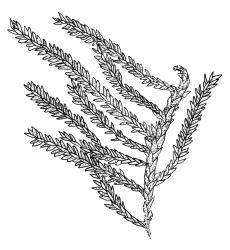Elements in the following description are taken from Noguchi (1987–1994) and Crum & Buck (1994).
Plants small to rather large, mostly yellow-, olive-, or glaucous-green, mostly forming interwoven mats on bark. Primary stems, when distinguishable, filiform and creeping, often stoloniferous, irregularly branched, with leaves reduced or none. Secondary stems spreading or ascendant, often curled when dry, lacking a central strand. Leaves erect or curved inwards when dry, often imbricate, spreading when moist, lingulate, ovate-lanceolate, or lanceolate, often from a broader and sometimes clasping base, rounded or less often acute at apex, occasionally fragile, entire or toothed; mid laminal cells mostly small, ± hexagonal or quadrate, usually pluripapillose, rarely unipapillose or smooth; alar cells not or poorly differentiated. Costa single and variable in length or rarely short and double. Paraphyllia lacking.
Dioicous. Perichaetial leaves moderately differentiated. Setae elongate, smooth; capsules erect, oblong, cylindric, rarely subglobose; stomata lacking or few; operculum rostrate or conic. Peristome double; exostome teeth pale, ± lanceolate, sometimes perforate along median line, coarsely papillose throughout or rarely cross-striolate; endostome usually reduced. Calyptra cucullate, smooth or sparsely hairy.
In its modern sense (sensu Goffinet et al. 2009), the Anomodontaceae are distinguished from often confounded families (especially Thuidiaceae and Leskeaceae) partly by having erect capsules with a non-hypnaceous peristome and a usually reduced endostome. Members of the Anomodontaceae also lack paraphyllia. Anomodon, of the northern hemisphere, is the largest genus in the family, which is represented in N.Z. only by Haplohymenium pseudotriste.
By contrast to the Anomodontaceae, members of the Thuidiaceae typically have curved capsules with a hypnoid peristome (including a well-developed endostome) and generally numerous paraphyllia with papillose cells. Members of the Leskeaceae (sensu Goffinet et al. 2009) have curved or erect capsules, a variable exostome (with reduced teeth associated with epiphytic habitats), mostly reduced endostomes, and paraphyllia with smooth cells.
The Anomodontaceae were treated as a subfamily of a broadly defined Thuidiaceae by Brotherus (1925, p. 311). The Anomodontaceae, Leskeaceae, and Thuidiaceae (defined similarly to the concepts employed by Goffinet et al. 2009) were discussed and given meaning in treatments for the Mexican flora by Crum & Buck (1994). In their discussion of the Anomodontaceae they differentiated between stoloniferous (and nearly leafless) primary stems and secondary stems. Crum & Buck make this distinction mostly in respect to Anomodon, where the plants are more robust than in Haplohymenium.
An alternative view (not adopted here) of the affinities of Haplohymenium is provided by Noguchi (1987–1994) who placed it in a broadly-defined Leskeaceae, as did Crum & Anderson (1981).
| Category | Number |
|---|---|
| Indigenous (Non-endemic) | 1 |
| Total | 1 |
The genus Anomodon has arguably been recorded from N.Z., but the sequence of records is very confusing. Brotherus (1900) described Anomodon tasmanicus based on a Weymouth collection from Knocklofty in Tasmania. Subsequently, Dixon & Sainsbury (1933) described Triquetrella curvifolia from two sterile syntypes from Hawke’s Bay L.D. Some years later, Sainsbury (1955, p. 474) stated his opinion that A. tasmanicus and T. curvifolia were conspecific and that the single species was "probably an Anomodon". Granzow-de la Cerda (1989) re-examined all the relevant type specimens and confirmed that A. tasmanicus Broth. and T. curvifolia Dixon & Sainsbury were heterotypic synonyms. He located terminal perichaetial buds in Tasmanian material (which preclude its retention in Anomodon) and made the required combination Triquetrella tasmanica (Broth.) Granzow-de la Cerda. J.E. Beever (pers. comm.) has confirmed this observation using more recently collected N.Z. material. Accordingly, the species in question is treated by us in Triquetrella, in Pottiaceae, as T. tasmanica.




